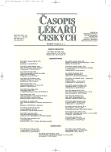Electronic cigarette
Authors:
Eva Králíková 1,2; Martin Ježek 3
Authors‘ workplace:
Univerzita Karlova v Praze, 1. lékařská fakulta, Ústav hygieny a epidemiologie VFN
1; Univerzita Karlova v Praze, 1. lékařská fakulta, III. interní klinika VFN, Centrum pro závislé na tabáku
2; Magistrát hlavního města Prahy
3
Published in:
Čas. Lék. čes. 2012; 151: 208-210
Category:
Special Articles
Overview
Electronic cigarette (e-cigarettes) belongs to the “ENDS (Electronic Nicotine Delivery Systems), ie systems that deliver nicotine electronically. Extract of tobacco does not burn, just warm. Vapors may or may not contain nicotine. E-cigarettes are also available with different flavors. They don’t produce a classic smoke. There is a large variability of these products. It seems that the initial negative position has to be reconsidered. Although there has been demonstrated trace amounts of several toxic substances in the vapor, the risk compared to traditional smoking is minimal. Moreover, lately it was shown that they can really contribute to smoking quitting. The legislative framework varies considerably, from the prohibition on sales to the recommended assistance in quitting. In the CR they are included according to the Act 379/2005 in 2009 among the tobacco products.
Key words:
electronic cigarette, e-cigarette.
Sources
1. World Health Organization. WHO study group on tobacco regulation. Geneva, Switzerland: WHO Press; 2009. (Technical Report 955).
2. Etter J-F, Bullen C, louris D, Laugese, M, Eissenberg T. Electronic nicotine delivery systems: a research agenda. Tob Control 2011; 20: 243–248
3. Hennigfield JE, Zaatari GS. Electronic nicotine delivery systems: emerging science foundation for policy. Tob Control 2010; 19: 89–90
4. FDA. Consumer Updates: FDA Warns of Health Risks Posed by E-Cigarettes. 2009 July 24, 2009; http://www.fda.gov/ ForConsumers/ConsumerUpdates/ucm173401.htm
5. FDA. Summary of results: Laboratory analysis of electronic cigarettes conducted by FDA. 2009 July 22, 2009, http://www.fda.gov/NewsEvents/PublicHealthFocus/ucm173146.htm
6. Westenberger BJ. Evaluation of e-cigarettes. Rockville, MD: US Food and Drug Administration, Center for Drug Evaluation and Research, Division of Pharmaceutical Analysis; 2009.
7. Laugesen M. Safety report on the Ruyan® e-cigarette cartridge and inhaled aerosol. Christchurch, New Zealand: Health New Zealand Ltd; 2008.
8. Bullen C, cRobbie H, hornley S, lover M, i, R, augese, M. Effect of an electronic nicotine delivery device (e cigarette) on desire to smoke and withdrawal, user preferences and nicotine delivery: randomised cross-over trial. Tob Control 2010; 19: 98–103
9. Etter J-F, Bullen C. Electronic cigarette: users profile, utilization, satisfaction and perceived efficacy. Addiction 2011; 106: 2017–2028
10. Darredeau C, Campbell M, Temporale K, et al. Subjective and reinforcing effects of electronic cigarettes in male and female smokers. 12th annual meeting of the Society for Research on Nicotine and Tobacco Europe. Bath, UK, 2010, https://secure2.symphonyem.co.uk/CMS/UserDocuments/899/Cathy%20Book1-121%20.pdf
11. Cho JH, Shin E, Moon SS. Electronic-cigarette smoking experience among adolescents. Journal of Adolescent Health 2011; 49: 542–546.
12. Sovinová H, Sadílek P, Csémy L. Vývoj prevalence kuřáctví v dospělé populaci ČR, názory a postoje občanů k problematice kouření (období 1997–2010), výzkumná zpráva. SZÚ 2011, dostupné na www.szu.cz.
13. Heavner K, Dunworth J, Bergen P, Nissen C, Phillips CV. Electronic cigarettes (e-cigarettes) as potential tobacco harm reduction products: Results of an online survey of e-cigarette users. www.tobaccoharmreduction.org, 2009.
14. Foulds J, Veldheer S, Berg A. Electronic cigarettes (e-cigs): views of aficionados and clinical/public health perspectives. International Journal of Clinical Practice 2011; 65: 1037–1042
15. Polosa R, aponnetto P, Morjaria JB, apale G,Campagna D, usso C. Effect of an Electronic Nicotine Delivery Device (e-Cigarette) on Smoking Reduction and Cessation: A Prospective 6-Month Pilot Study. BMC Public Healt 2011; 786.
16. Eissenberg T. Electronic nicotine delivery devices: ineffective nicotine delivery and craving suppression after acute administration. Tob Control 2010; 19: 87–88.
17. Etter J-F, Pauwels W. Saliva cotinine levels in users of electronic cigarettes, Eur Resp J 2011; 38: 1219–1220.
18. Trehy M, Ye W., Hadwiger M, Moore T, Allgire J, Woodruff J, Ahadi S, Black J, Westenberger, B. Analysis of electronic cigarette cartridges, refill solutions, and smoke for nicotine and nicotine related, Journal of Liquid Chromatography Related Technologies 2011; 34: 1442–1458.
19. Trtchounian A, Williams M, Talbot P. Conventional and electronic cigarettes (e-cigarettes) have different smoking characteristics. Nicotine Tobacco Research 2010; 12: 905–912.
20. Flouris AD, Oikonomou DN. Electronic cigarettes: miracle or menace? British Medical Journal 2010; 340: 311. INCHEM, I.P.o.C.S.I. Nicotine. 1991 [cited 2009 August 12, 2009]; Available from: http://www.inchem.org/documents/ pims/ chemical/nicotine.htm
21. Hadwiger ME, Trehy ML, e , Moore T, llgire J, estenberger B. Identification of amino-tadalafil and rimonabant in electronic cigarette products using high pressure liquid chromatography with diode array and tandem mass spectrometric detection. Journal of Chromatography 1217 2010; 48: 7547–7555.
Labels
Addictology Allergology and clinical immunology Angiology Audiology Clinical biochemistry Dermatology & STDs Paediatric gastroenterology Paediatric surgery Paediatric cardiology Paediatric neurology Paediatric ENT Paediatric psychiatry Paediatric rheumatology Diabetology Pharmacy Vascular surgery Pain management Dental HygienistArticle was published in
Journal of Czech Physicians

Most read in this issue
- Cystic polyposis of the stomach (fundic gland polyps) – relationship to the absence of Helicobacter pylori infection and a therapy with drugs suppressing gastric acidity
- Electronic cigarette
- Determination of needs of terminally ill patients in the hospice care
- Perspectives on pharmacological and clinical benefits from sirtuin 1 activators in oxidative damage
